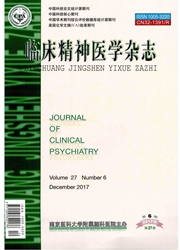

 中文摘要:
中文摘要:
目的:对比分析高功能孤独症谱系障碍(ASD)儿童青少年患者的全脑白质结构网络的拓扑属性特征。方法:对36例6~16岁高功能ASD患者以及39例年龄、性别以及智商相匹配的正常发育儿童对照组(TD组)进行弥散张量成像(DTI)扫描,在纤维追踪技术的基础上运用基于图论的分析方法分析两组被试脑网络的拓扑属性值,并进一步探讨高功能ASD儿童青少年脑网络拓扑属性特征值与年龄以及临床症状之间的相关性。结果:与TD组相比,高功能ASD儿童青少年脑结构网络的全局拓扑属性异常,表现为局部效率(Eloc)(P=0.02)和校正集群系数(γ)的显著降低(P=0.00)。结论:儿童青少年期高功能ASD全脑白质结构网络存在着小世界属性;与TD组相比,高功能ASD组全脑局部信息处理效率降低。
 英文摘要:
英文摘要:
Objective: To comparatively analyze the topological property alterations of the whole-brain white-matter structural network between high-functioning autism spectrum disorder( ASD) in children and adolescents. Method: This study used diffusion tensor image tractography to construct the human brain whitematter networks of 36 high-functioning ASD children and adolescents ranging from 6 to 16 years old and 39 age and gender matched typically developed( TD) controls,followed by a graph theoretical analysis to establish topological structures of the cerebral anatomical network,and further to explore the relationship between topological properties and clinical symptoms of the high-functioning ASD group. Results: Compared with TD group,the global topological properties of the brain white-matter networks in high-functioning ASD children and adolescents were abnormal,as obviously indicated by decreased local efficiency( Eloc)( P = 0. 02) and the coefficient cluster( γ)( P = 0. 00). Conclusion: The high-functioning ASD children and adolescents exhibit "smallworld"character of the whole-brain white-matter structural network. Compared with the TD group,high-functioning ASD group shows decreased efficiency of local information processing in the whole brain.
 同期刊论文项目
同期刊论文项目
 同项目期刊论文
同项目期刊论文
 期刊信息
期刊信息
